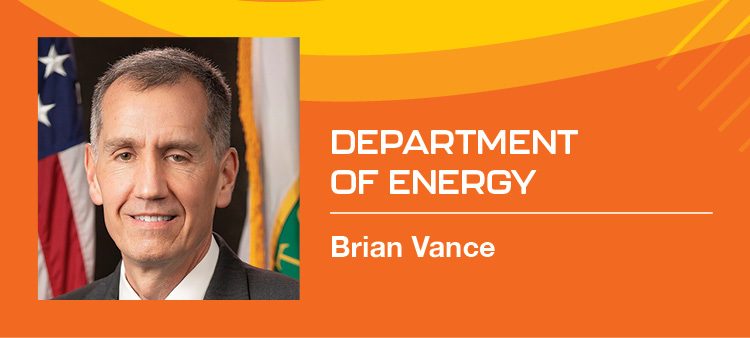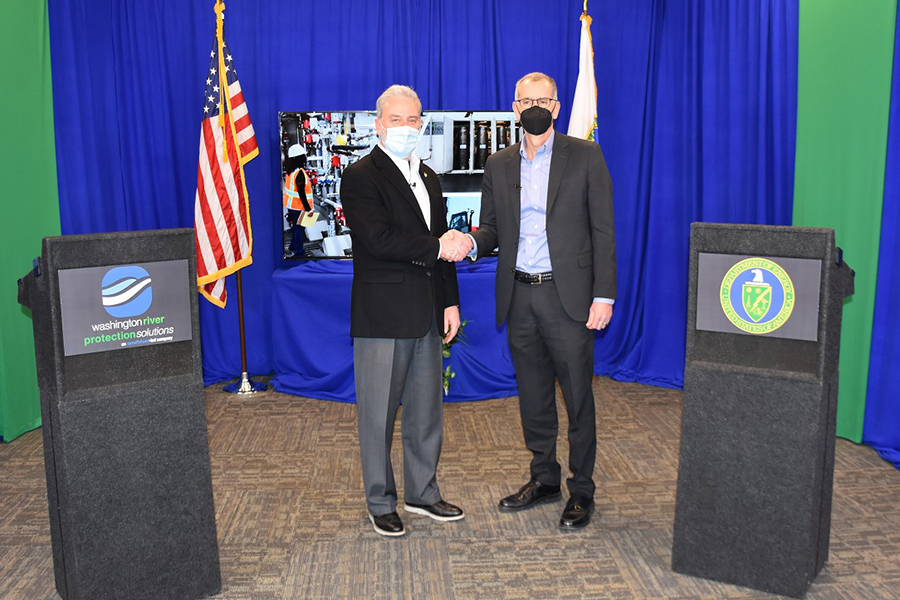
Home » Our progress lays foundation for new cleanup era at Hanford
Our progress lays foundation for new cleanup era at Hanford

April 14, 2022
Over the past year, the U.S. Department of Energy (DOE) and our contractor partners have made significant cleanup progress while establishing the safest possible environment for our workforce during the pandemic. Our One Hanford team has a lot to be proud of as we prepare to begin the next important chapter of our cleanup mission of the Hanford site.
2021 began with headlines to share the news that workers had finished constructing all Waste Treatment and Immobilization Plant facilities needed for the Direct-Feed Low-Activity Waste program, or DFLAW. The program involves a set of interdependent facilities and infrastructure systems operating together to successfully treat, vitrify (immobilize in glass) and dispose of millions of gallons of low-activity tank waste.
Over the summer, when DOE, state and contractor officials announced that workers had made the 3,500-foot pipeline connection between Hanford tanks and the Waste Treatment Plant, regional editorial boards praised the accomplishment and recognized Hanford is taking huge steps forward as we prepare to vitrify tank waste.

Last fall, the DFLAW program took another giant stride forward when workers finished building and testing the Tank-Side Cesium Removal system, completing one of the top 2021 priorities of the DOE Office of Environmental Management, the office responsible for the safe and efficient cleanup of multiple defense production sites across the country.
Treating tank waste
In January of this year, we started operating the system and entered a new era of our Hanford cleanup mission, the start of industrial-scale tank waste treatment. The treated waste is being staged until it can be fed directly to the nearby vitrification plant when it comes online next year.
At the Waste Treatment Plant, workers completed testing on all the individual systems in 2021 and moved into the commissioning phase, where integrated systems and facility-level testing is underway. The first major commissioning test was successfully conducting a loss of electrical power to ensure backup systems functioned as expected. The next major commissioning step is to begin heating up the first of two 300-ton melters later this year.
Other projects to support DFLAW across the site, including construction, facility upgrades and permitting activities, remained on track to support safe and efficient preparations for the initiation of treating tank waste by the end of 2023.
Groundwater treatment
Beyond the DFLAW program, our team continued to deliver taxpayer value in 2021 by safely progressing cleanup projects and conducting site operations that enhance the safety of our workforce and the public and reduce environmental risks.
For the seventh year in a row, crews treated more than 2 billion gallons of contaminated groundwater for a total of 28 billion gallons since the project began in the mid-1990s. The groundwater treatment systems are part of an overarching effort to remove contaminants deposited during past operations from the ground to safeguard the Columbia River.
After demolishing the former Plutonium Finishing Plant, the Hanford team finished removing debris and sampling the soil. Now the site is covered with sand and gravel, fortified with a fixative and routinely monitored to ensure that the area remains safe for our workforce. Workers also finished stabilizing underground waste disposal structures near the former plant that were considered at risk of collapsing, achieving another Office of Environmental Management priority for 2021.
Workers also began preparing the foundation for construction of a weather-resistant structure that will cover the K East Reactor until radioactive material in the reactor core has decayed to levels safe for future demolition. By the end of 2023, the K East Reactor will be the seventh of eight former plutonium production reactors that will be placed in interim safe storage, or “cocooned.” With the historic B Reactor preserved as part of a national park, when the K West Reactor is also placed in interim safe storage by the end of the decade, all the reactors that operated at the Hanford site will be in a safe and sustainable configuration for decades.
Site infrastructure
Our Hanford team also remains focused on right-sizing and modernizing our site infrastructure to support our future cleanup effort. In October, workers started building a new 10,000-square-foot Central Plateau Water Treatment Facility to replace the water plant that was built during the Manhattan Project, with a modern and supportable facility that will affordably deliver potable water to our site. We also are working on infrastructure projects, large and small, to ensure that our site’s electrical distribution system, information technology systems, water and sewer systems, and roads continue to support safe and cost-efficient cleanup progress.
Environmental legacy
As we meet our responsibility to address the environmental legacy of Hanford, the site is fortunate to be surrounded by a skilled set of local industry partners, including small businesses that help us deliver results. Hanford also is surrounded by a diverse community and tribal nations who are important partners in planning for a safe and sustainable future. Ensuring that those most impacted by the environmental legacy of the past and the cleanup mission of today have a voice that provides valuable insight as we prioritize and plan cleanup.
As the Hanford team progresses its cleanup mission, stewardship of both natural and cultural resources on the 580-square-mile Hanford site is also one of DOE’s important responsibilities.
We work closely with local communities, and we engage with Native American tribes to provide the opportunity for them to share their perspectives and provide input on cleanup priorities and activities. Our stewardship role also has led to agreements with the U.S. Department of the Interior to manage most of the lands that make up the Hanford Reach National Monument.
We also are committed to carrying out our mission in a sustainable manner that minimizes the impact of emissions. This year, we are updating our assessment of site systems, operations and facilities to help us continue to be proactive about enhancing the resilience of our facilities and adapting to climate change.
Workforce
Every successful enterprise is built and sustained by people. The Hanford site is no different, and the people that make up our team are our most important asset. While our cleanup effort is technically complex and the largest of its kind in our nation, our Hanford workforce continues to deliver safe and efficient progress through dedication and exceptional teamwork.
Our Hanford team is devoting its energy and expertise to further our important cleanup mission, while consistently delivering positive results for our site, our community and the environment of the Pacific Northwest. Looking to the future, we also are working with industry, labor and academia to develop a diverse and talented next generation of talented professionals who are ready for the challenges and satisfaction of delivering cleanup progress and risk reduction.
I am proud of the many important achievements that our Hanford team has safely delivered during challenging times.
Given the exceptional accomplishments over the last few years, and especially this last year, I am very optimistic about our site’s future. Finally, I am grateful to have the opportunity to work with the exceptional professionals of our Hanford workforce team, and I look forward to ushering in the next exciting phase of our site mission with the start of tank waste treatment.
Brian Vance is the manager of the U.S. Department of Energy Office of River Protection and Richland Operations Office.
Hanford
KEYWORDS april 2022




